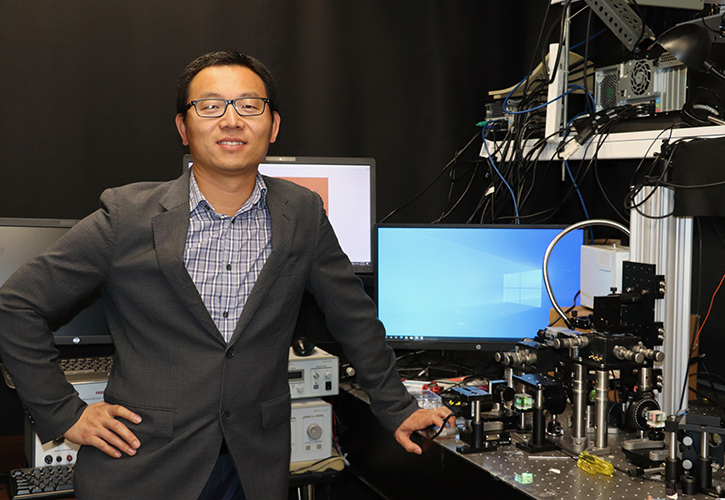College of Arts and Sciences Newsroom

National Institutes of Health awards University of Dayton researcher $1.5 million to develop super-resolution imaging system for nanoscale structures
By Dave Larsen
The National Institutes of Health awarded University of Dayton physics researcher Chenglong Zhao a four-year, $1.5 million grant to develop a new super-resolution imaging system that can provide high-quality images of biological structures 10,000 times smaller than a human hair. The technology could provide new insights into a variety of biological processes.
Zhao, associate professor of physics and electro-optics, is principal investigator on the grant, which started Sept. 15 and runs through July 2025.
In 2018, Zhao received a $317,158 National Science Foundation grant, with $63,215 in supplemental funding awarded in 2020, to develop an advanced manufacturing process for building three-dimensional structures at “nanoscale,” with measurements in billionths of a meter.
Viewing those nanostructures via a conventional optical microscope proved difficult because such devices are limited by the diffraction of light.
“We are developing a new optical imaging technology so that we can really see some very small structures that normally you cannot see with a traditional optical microscope,” Zhao said. “We are trying to develop a new method to see these nanostructures.”
A number of super-resolution 3D imaging technologies have been developed during the past two decades to enable researchers to observe nanoscale structures. However, these technologies are limited in terms of their resolution, field-of-view, image speed and ease of use.
Zhao and his co-investigator Tony Jun Huang, the William Bevan Distinguished Professor of Mechanical Engineering and Materials Science at Duke University, recently developed an “acoustofluidic scanning nanoscope” that can achieve both super resolution and large field-of-view imaging in two dimensions. Under the National Institutes of Health (NIH) grant, they will develop and validate a 3D model that resolves the shortcomings of other super-resolution systems.
Their technology uses microspheres, or tiny polymer spheres about 20 micrometers in size. To scan an object, they move a large number of microspheres across its surface using acoustic waves. The images are then gathered together to create one large digital super-resolution image.
By using acoustics to simultaneously manipulate multiple microsphere lenses, Zhao’s proposed method will provide a large field-of-view while maintaining superior resolution. It will achieve a resolution that is four times higher than a confocal laser scanning microscope, which has a limit of 200 nanometers. In addition, its imaging speed is 10 times faster than a confocal microscope.
The technology will allow bioscience and medical researchers to observe cellular and subcellular structures at the nanoscale, making the optical imaging of more detailed inner architecture of many subcellular structures possible.
“The NIH has high demand to develop this super-resolution imaging technology,” Zhao said. “There are huge applications there.”
For ease of use, the device can be seamlessly connected to a conventional optical microscope without modification to the optical setup, which can significantly reduce the cost and complexity of operation.
“One of our aims is to get a patent on this technology and, hopefully, get a prototype and commercialize it to optical microscope manufacturers,” he said.
Under the NIH grant, Zhao will hire a postdoctoral researcher to collaborate on his research. He also will include a graduate student on the project.
Zhao joined the University faculty in 2015 and holds a joint appointment in the Department of Physics and the School of Engineering's Department of Electro-Optics and Photonics. He received his doctorate in 2011 from Peking University in Beijing, China.
“Dr. Zhao is one of the physics department’s outstanding young faculty members and has distinguished himself through his research with nanomaterials,” said Todd Smith, associate professor and interim Department of Physics chair. “His new NIH grant will allow him to further his research in nano-photonics and nano-manufacturing, and provide additional opportunities for cutting-edge research by undergraduate and graduate students in his lab.”
Andrew Sarangan, professor and Department of Electro-Optics and Photonics chair, said Zhao’s work benefits the department’s recruitment and reputation.
“Dr. Zhao’s nationally recognized work on nano-photonics has been a magnet for our graduate students,” Sarangan said. “He is a perfect example of how cross-cutting interdisciplinary research can lead to a successful outcome.”
For more information, visit the Nano-photonics & Nano-manufacturing lab and Department of Physics website.
